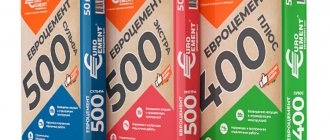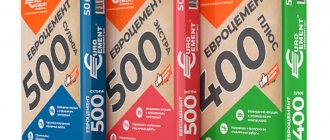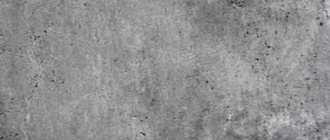How is M500 cement made?
If you carefully examine the packaging of the dry mix, it becomes clear that this building material is made of lime, silica, aluminum, gypsum and iron oxide.
During the production process of cement, all components are thoroughly ground into fine crumbs and mixed in certain proportions. At the output, the manufacturer receives a finely ground mineral powder with a gray-green tint.
The manufacturing technology is strictly controlled by GOST 10178-85, due to which the product is characterized by the highest quality. However, despite its unsurpassed performance characteristics, the cost of M500 cement is very affordable, thanks to which it has earned enormous popularity among developers.
Scope of application
Today, Portland cement is actively used for the following purposes:
• for arrangement of the roadway;
• during the construction of monolithic reinforced concrete structures;
• in the construction of dams, piers and other hydraulic structures;
• for quickly creating formwork for the foundation;
• when constructing runways at airfields;
• for creating beams, floor slabs and other structures of special reliability;
• during emergency repairs of emergency structures;
• for creating eurofences and paving slabs;
• for the construction of foundations in areas with high water levels.
Today, Portland cement is used to make mixtures necessary for masonry work, heavy concrete and mortars for plastering surfaces.
In addition to the construction industry, M500 products (white cement) are used to create various decorative elements. It is used to make complex statues, columns, cladding materials for facades and other elements used in landscape design.
The best cement brand M400
Cement compositions of the M400 brand are intended for the preparation of medium-strength concrete. They are most often used when constructing screeds, constructing internal partitions, and leveling surfaces with large differences. Experts noted several trusted manufacturers.
Cement Eurocement M400 D20 CEM II A-Sh 32.5
Rating: 4.9
The leading position in the Russian construction market is held by the domestic one. The most popular brand of cement is Eurocement M400 D20. The holding's production facilities are located in different regions of the country. The composition with this designation is produced by such enterprises as Mordovcement, Mikhailovcement, Pikalevsky Cement. The product meets all the requirements of international standards, therefore it is exported to a number of neighboring countries. The building mixture is used in the construction industry and in industry. Cement is used to make floor slabs, reinforced concrete structures, foundations, walls, etc. The domestic product is moisture and frost resistant. The composition can be stored in closed bags for up to 6 months.
Advantages
- acceptable price;
- water and frost resistance;
- high quality;
- wide scope of application.
Flaws
- not detected.
Basic properties of the material
Cement (of this type) has earned great demand and consumer trust due to its high strength indicators. The index 500, present in the marking of the material, indicates that the hardened solution can withstand loads of up to 500 kg per square centimeter. That is why in some cases the M500 (cement) mixture is simply irreplaceable.
Calcium silicates included in the product make it resistant to sudden temperature fluctuations and prevent the appearance of cracks in constructed buildings. The material is not afraid of frost and gains strength very quickly, which makes it possible to carry out concreting work on surfaces even in winter.
Based on consumer reviews, we can conclude that the mixture also has the following qualities:
• resistance to corrosion and aggressive environments;
• excellent resistance to strong mechanical loads;
• complete absence of interaction with moisture;
• minimal shrinkage;
• good elasticity;
• fast setting.
In order for the above properties to be maintained during the operation of a Portland cement product, it should not be mixed with other brands, since in this case the M500 material (cement) loses its original characteristics.
Should I use cement with slag or not?
Cement manufacturers specifically use mineral additives to mix the clinker concentration, according to DSTU. After all, in principle, pure cement without additives (prefix d0) means that it is without additives, or they also say “zero”.
Therefore, you should not be afraid of cement with the addition of slag, just choose a brand that suits your purposes, and for clarity, we provide a table indicating the brand and the percentage of additives:
| Cement grade (M) | % clinker | % slag |
| 500 d0 | 95-100 | 0 |
| 500-A | 80-94 | 6-20 |
| 400-B | 65-79 | 21-35 |
| ShPTs-A | 35-64 | 36-65 |
| ShPTs-B | 20-34 | 66-80 |
It is worth noting, in fairness, that when buying several bags or one or two tons, the developer chooses cement of a higher grade, since the price is not so high. But for industrial volumes of construction, the price of cement will play a decisive role and the construction company will be attentive to the choice of brand.
Specifications
The information provided by the manufacturer on the packaging of the dry mixture indicates the following indicators of the product:
• maximum compressive strength – 49-50 MPa (occurs 28 days after pouring the solution);
• maximum bending strength – 6.7-6.9 MPa (after 4 weeks, and depends on the modification of the cement);
• time for complete setting of the solution – 3-4 hours;
• complete hardening of the surface – after 28 days;
• in closed packaging the mixture can be stored for up to 1 year;
• density – 3000 – 3200 kg per cubic meter;
• radioactivity – class 1 (up to 370 BC/kg);
• expansion (when the solution hardens) – up to 10 mm;
• bulk density - 1000 kg per cubic meter;
• bulk density of the material in a compacted state – 1600 kg per cubic meter.
The grinding fineness of all components of the mixture is 92%. This indicator has a direct impact on the setting speed of the finished solution - the smaller the fraction, the less time it will take to harden.
These characteristics allow us to conclude that M500 cement (the price of which is pleasantly surprising) meets all domestic standards and rightfully bears the title of a high-quality product.
Types of Portland cement
This brand of cement is divided into two main types: the standard composition M500 D0 and the modified product M500 D20.
The first variety is characterized by the absence of additional components, that is, the mixture is presented in its pure form. This cement is used in industrial and large-scale construction, since it is most resistant to frost, moisture and various mechanical influences.
The M500 D20 marking indicates that the mixture contains various additives, the total amount of which is within 20% of the total mass. This cement has all the previously listed positive properties, but is more resistant to corrosion. When carrying out large-scale and minor repairs, craftsmen use exactly this M500 cement. The price (kg, tons and bag) of this variety is slightly higher, which is due to the large number of components of the mixture.
Rating of the best cement manufacturers
| Nomination | place | Name of product | price |
| The best cement brand M400 | 1 | Cement Eurocement M400 D20 CEM II A-Sh 32.5 | 372 ₽ |
| 2 | Holtzim M400 | 263 ₽ | |
| 3 | Portland M400 Hercules | 690 ₽ | |
| 4 | Cement CEM II 32.5 (M400 D20) gray De Luxe | 298 ₽ | |
| The best cement brand M500 | 1 | Eurocement 500 Super | 382 ₽ |
| 2 | Holcim ExtraCem M-500 50kg | 311 ₽ | |
| 3 | EuroCement 500 Extra D20 CEM II 42.5 N | 379 ₽ | |
| 4 | Stone flower M500 D20 | 255 ₽ | |
| The best cement brand M600 | 1 | CimSa M600 | 820 ₽ |
| 2 | Adana Super White M-600 | 980 ₽ | |
| 3 | White polymer cement M600 Rusean | 592 ₽ |
What do the additional letters on the product label mean?
When purchasing Portland cement of this variety, you should pay attention to the presence of additional symbols in its labeling. They indicate the special physical and technical properties of the material and clarify the scope of its application. The following letters can be seen in the name:
• N – a standardized amount of clinker was used in the production of the material;
• B – cement is characterized by very fast setting and can be used to eliminate water accidents;
• PL – plasticizers have been added to the mixture, making the solution resistant to sub-zero temperatures;
• VRC – cement resists the effects of water, hardens very quickly and can be used for emergency sealing of cracks and crevices;
• GF – hydrophobic material practically does not absorb moisture;
• BC – a white mixture intended for artistic works;
• CC – cement has increased resistance to sulfates and other aggressive environments;
• ShPC - indicates that the composition contains many additives, and their amount exceeds 20%.
Based on the area of use of the material, you should choose the most suitable M500 cement. Each variety has its own price, but its difference, as a rule, is not too significant.
In what form can Portland cement be purchased?
This product is sold in the form of a dry powder, which must be diluted with water immediately before starting work. M500 cement is sold in bags at construction sites. The weight of one package can be 45 and 50 kg (depending on the type of mixture).
If the material is needed for large-scale construction, it is better to buy it from large trading enterprises and directly from the manufacturer. In this case, the buyer has the opportunity to purchase the mixture in tons, with delivery to the construction site.
Properties of cement 400
M400 brand cement is one of the most popular. It is used in both private, industrial and public construction.
It can be marked in different ways:
- M400 . This is an old marking, adopted back in the USSR. It reflects the strength of hardened concrete: every 1 sq. cm can withstand up to 400 kg after complete hardening (28 days).
- CEM 32.5 . According to the new classification, the strength indicator is expressed in MPa (megapascals) and is 32.5.
In addition, the brand must indicate the available additives. The latter can accelerate or slow down hardening, increase resistance to water or low temperatures, and enhance resistance to rust. Some additives make it possible to transport cement over long distances without problems.
Source rosgranitsa.ru
Depending on the amount of additives, M400 cement is divided into several types:
- D0 . It contains no additives, it consists only of clinker. It has good frost resistance, average deformation during hardening and frost resistance. Used in public construction. This is the most expensive option.
- D5 . Contains up to 5% impurities. It has high anti-corrosion properties and repels moisture well. It is used in the construction of floors and load-bearing structures.
- D20 . Contains up to 20% additives. It is characterized by high frost resistance and water resistance, and can be used for the construction of underwater structures. It is used in the construction of residential and industrial premises.
They also produce sulfate-resistant cement (for use in aggressive environments and under water), expanding cement (for sealing cracks in walls, tunnels and mines) and others.
Source profundamenti.ru
Concrete grade M400 is universal. Its advantages include:
- High durability even when deviating from the instructions and ease of operation;
- When hardened, it shrinks slightly . This allows you to avoid cracks during hardening and accurately calculate the amount of cement;
- Good frost resistance : cement can withstand from -60 to +300 degrees;
- Rapid hardening : within 6 hours the concrete will harden and work can continue. It will take up to 3 weeks to fully cure, but the process can be speeded up by increasing the temperature or humidity.
To obtain additional characteristics, certain impurities can be added to M400.
It is important to remember that this cement is not suitable for the construction of buildings that experience additional load.
Price
Of course, the most important criterion that interests every reader who decides to purchase M500 cement will not be ignored - the price of a 50 kg bag of the mixture. As already mentioned, the product does not belong to the class of expensive materials and is quite affordable to the average buyer.
The cost of one bag may vary slightly depending on the region of sale, but on average varies from 140 to 280 rubles. The exact price for this product can be found from the manufacturer in your city or on the websites of trading companies.
Sellers quote a slightly different price to wholesale buyers who purchase M500 cement in bulk form. Retail and wholesale always differ in price tags, and this case is no exception.
Today, the average cost of one ton of class B mixture is 2,700 rubles. Cement, in the production of which a standardized amount of clinker was used, will have a price tag of about 3,100 rubles per ton of weight. White compositions will cost the buyer a little more.
What is the “right” color of cement?
The color scheme of cement is also a small point of discussion and comparison among the public under construction. Here you can notice the main thing - the color of cement is not a clear qualitative definition. Many people believe that the darker the color of the cement, the stronger it will be and vice versa. But everything is not so simple, since manufacturing plants do not receive their raw materials from one resource base, they have many suppliers from various metallurgical plants for slag and quarries for clinker, and not only in Ukraine, supplies are also imported.
Therefore, it is necessary to take into account that the color shade of the cement will depend on the raw materials and you should not worry about this fact. The light shade of cement is associated with the properties of the raw materials used and the mineralogical composition of the clinker. In addition, the color is affected by the fineness of cement grinding. The more the cement is crushed, the better quality it is, and the lighter its shade.
Summing up
M500 cement (50 kg and bulk) is very popular due to the fact that solutions made on its basis set very quickly, and structures are strong and durable. By using Portland cement in large-scale construction, developers significantly reduce the construction time of buildings and the labor costs of workers. The low cost and excellent performance characteristics of the material contribute to expanding the scope of its application and increasing demand, which means we will see the M500 product on the shelves of domestic counters for a long time.
We hope that the above information was useful to you, and in this article you found answers to all your questions. Happy shopping and fast construction!
Pros and cons of the material
Among the operational advantages of Portland cement M500, which make the material attractive for various areas of construction activity:
- ease of use, since here the preparation of the solution comes down to thoroughly mixing a mixture of water, cement, sand and, if necessary, crushed stone in specified proportions;
- chemical inertness, which implies resistance of finished concrete products and building structures to corrosion, exposure to alkalis, salts and acids;
- environmental friendliness, since the material does not contain toxic substances, the fumes of which can cause harm to humans and the environment;
- the optimal combination of strength, moisture resistance and durability of finished structures;
- moderate consumption of building materials, helping to minimize the developer’s costs.
The only significant drawback of M500 cement is its cost, which is slightly higher than that of lower grades of material. This partly constrains its use in the construction of unloaded structures and buildings that are not subject to special external aggressive influences.











